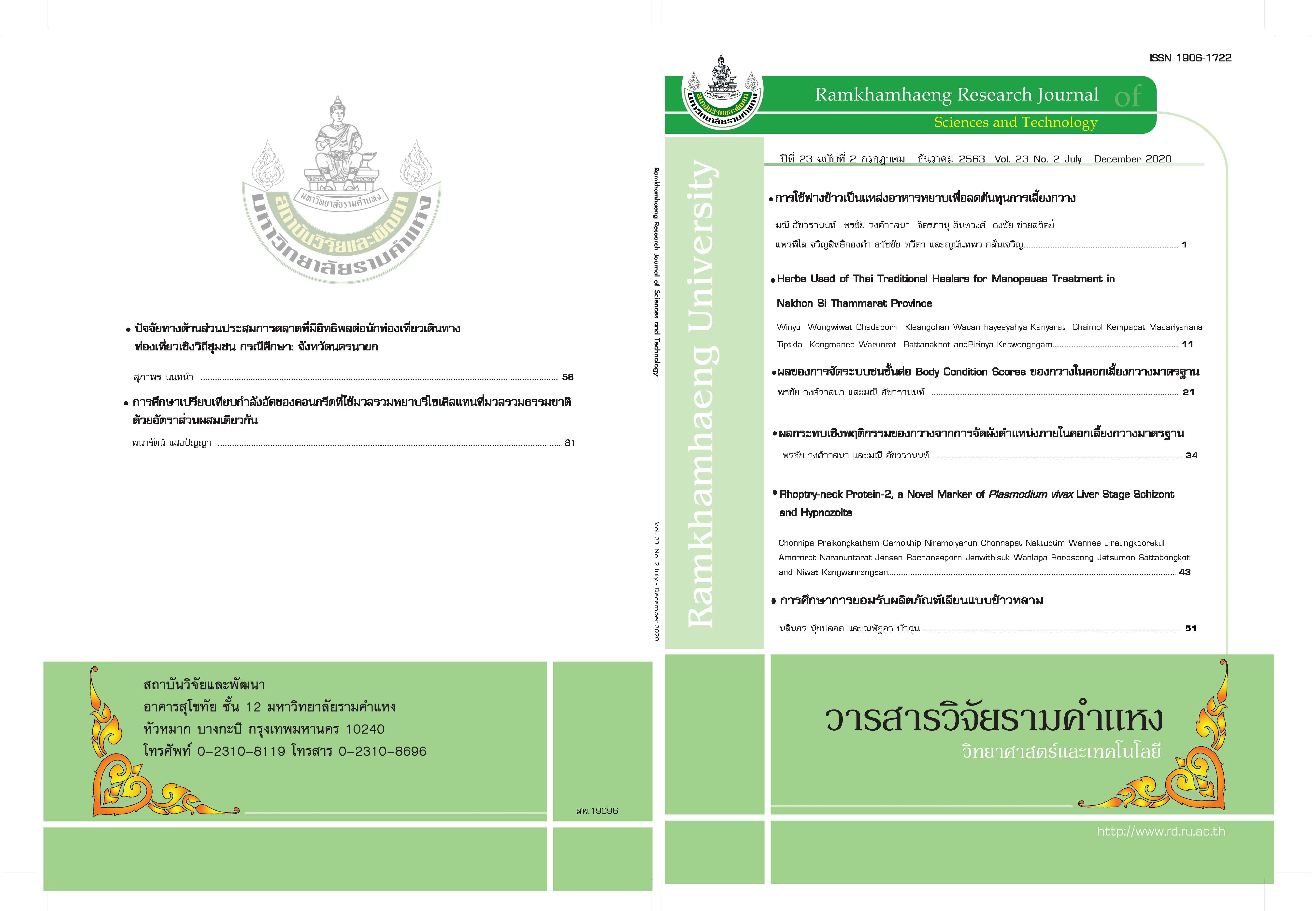Rhoptry-neck Protein-2, a Novel Marker of Plasmodium vivax Liver Stage Schizont and Hypnozoite
Main Article Content
Abstract
Relapse is a serious problem caused by vivax malaria. The dormancy stage called hypnozoite can be latent in the hepatocyte for several weeks or years, waiting for reactivation before developing into liver stage schizont. The biology of hypnozoite is not well understood. Furthermore, the study of the liver stage of human malaria is also difficult, due to the lack of small laboratory animal models and the restriction of specific binding molecules between human malaria parasites and human host cells. Thus, the study of the hypnozoite marker would be beneficial for further study of hypnozoite biology and the relapse mechanism. Rhoptry Neck Protein-2 (RON-2), the well-known rhoptry marker, was reported for localization in the invasive stage of the malaria parasite including sporozoite and merozoite, the invasive stages for hepatocytes and erythrocyte respectively. However, there are no reports for the expression of RON-2 in the liver stage. Therefore, we hypothesized that RON-2 which was found to be involved in the invasion process would be expressed in liver stage parasites and would be used as a marker for liver stage schizont and hypnozoite. Here, the human hepatocyte chimeric mice were infected with P. vivax sporozoites before collecting the infected liver tissue for examination using the immunofluorescent technique. The results showed that RON-2 was expressed at the apical end of P. vivax sporozoites and merozoites. However, RON-2 was localized in the surroundings of liver stage schizonts and hypnozoites, and co-localized with Up-regulation in infective sporozoites protein 4 (UIS-4), a well-known form of PVM protein. In conclusion, RON-2 localized at the PVM of the liver stages of schizont and hypnozoite, can be a novel marker for the identification of P. vivax liver stage schizont and hypnozoite. This could be beneficial for further investigation on the treatment and control of the relapse caused by vivax malaria.
Article Details
Ramkhamhaeng University
References
Arévalo-Pinzón, G., Curtidor, H., Patiño, L. C. and Patarroyo, M. A. 2011. PvRON-2, a new Plasmodium vivax rhoptry neck antigen. Malar J. Vol. 10(60).
Cui, M., Jiang, L., Goto, M., Hsu, P., Li, L., Zhang, Q., Xie, L. 2017. In Vivo and Mechanistic Studies on Antitumor Lead 7-Methoxy-4-(2-methylquinazolin-4-yl)-3,4-dihydroquinoxalin
-2(1H)-one and Its Modification as a Novel Class of Tubulin-Binding Tumor-Vascular Disrupting Agents. J. Med. Chem. Vol. 60(13): 5586-5598.
Delgadillo, R. F., Parker, M. L., Lebrun, M., Boulanger, M. J. and Douguet, D. 2016. Stability of the Plasmodium falciparum AMA1-RON-2 Complex Is Governed by the Domain II (DII) Loop. PloS one. Vol: 11(1): e0144764-e0144764.
Lamarque, M., Besteiro, S., Papoin, J., Roques, M., Vulliez-Le Normand, B., Morlon-Guyot, J. and Lebrun, M. 2011. The RON-2-AMA1 interaction is a critical step in moving junction-dependent invasion by apicomplexan parasites. PLoS Pathog. Vol. 7(2): e1001276.
Mikolajczak, S. A., Vaughan, A. M., Kangwanrangsan, N., Roobsoong, W., Fishbaugher, M., Yimamnuaychok, N. and Kappe, S. H. 2015. Plasmodium vivax liver stage development and hypnozoite persistence in human liver-chimeric mice. Cell Host Microbe. Vol. 17(4): 526-535.
Mueller, I., Galinski M. R., Baird J. K., Carlton J. M., Kochar D. K., Alonso P. L., del Portillo H. A. 2009. Key gaps in the knowledge of Plasmodium vivax, a neglected human malaria parasite. Lancet Infect Dis. Vol. 9(9): 555-566.
Nyboer, B., Heiss, K., Mueller, A. K. and Ingmundson, A. 2018. The Plasmodium liver-stage parasitophorous vacuole: A front-line of communication between parasite and host. Int J Med Microbiol. Vol. 308(1): 107-117.
Price, R. N., Tjitra, E., Guerra, C. A., Yeung, S., White, N. J. and Anstey, N. M. 2007. Vivax malaria: neglected and not benign. Am J Trop Med Hyg. Vol. 77(6 Suppl): 79-87.
Roobsoong, W., Maher, S. P., Rachaphaew, N., Barnes, S. J., Williamson, K. C., Sattabongkot, J. and Adams, J. H. 2014. A rapid sensitive, flow cytometry-based method for the detection of Plasmodium vivax-infected blood cells. Malar J. Vol. 13(55).
Salgado-Mejias, P., Alves, F. L., Françoso, K. S., Riske, K. A., Silva, E. R., Miranda, A. and Soares, I. S. 2019. Structure of Rhoptry Neck Protein 2 is essential for the interaction in vitro with Apical Membrane Antigen 1 in Plasmodium vivax. Malar J. Vol. 18(1).
Shen, B. and Sibley, L. D. 2012. The moving junction, a key portal to host cell invasion by apicomplexan parasites. Curr Opin Microbiol. Vol. 15(4): 449-455.
Spielmann, T., Montagna, G. N., Hecht, L. and Matuschewski, K. 2012. Molecular make-up of the Plasmodium parasitophorous vacuolar membrane. Int J Med Microbiol. Vol. 302(4-5): 179-186.
Swearingen, K. E., Lindner, S. E., Shi, L., Shears, M. J., Harupa, A., Hopp, C. S. and Sinnis, P. 2016. Interrogating the Plasmodium Sporozoite Surface: Identification of Surface-Exposed Proteins and Demonstration of Glycosylation on CSP and TRAP by Mass Spectrometry-Based Proteomics. PLoS Pathog. Vol. 12(4): e1005606.
World Health Organization. 2018. WHO malaria report 2018. Lexembourg. DesignIsGood.
info.


